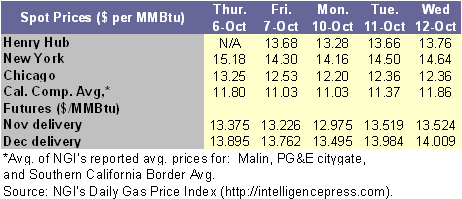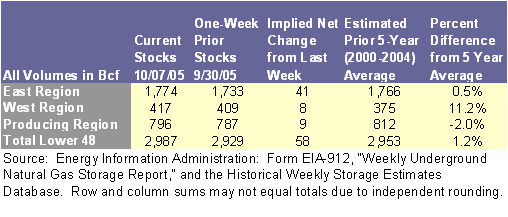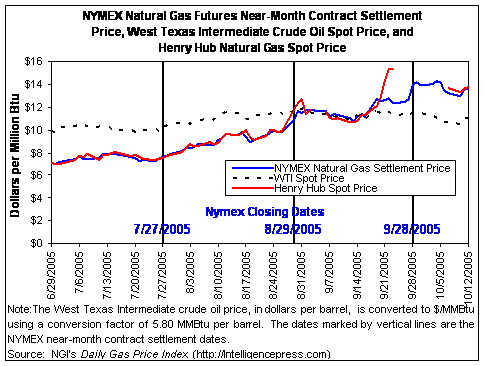
Natural Gas
Natural Gas Weekly Update Archive
for week ending October 12, 2005 | Release date: October 13, 2005 | Previous weeks
Overview:
Thursday, October 13 (next release 2:00 p.m. on October 20)
Since
Wednesday, October 5, natural gas spot prices decreased at virtually all market
locations in the Lower 48 States, with decreases exceeding $1 per MMBtu at most markets.
Trading resumed at the Henry Hub on Friday, October 7, for the first
time since Friday, September 22, when prices at the Henry Hub averaged
$15.27. Trading at the hub was suspended
because Sabine Pipeline had declared a force majeure,
which prevented or reduced gas flow operations at the hub. On Wednesday, October 12, prices at the Henry
Hub averaged 13.76 per MMBtu, increasing $0.08 per MMBtu, or less than 1 percent, since Friday, October
7. Yesterday (October 12), the price of
the NYMEX futures contract for November delivery at the Henry Hub settled at
$13.524 per MMBtu, declining about 66 cents or nearly
5 percent since Wednesday, October 5.
Natural gas in storage was 2,987 Bcf as of
October 7, which is about 1 percent above the 5-year average. The spot price for West Texas Intermediate
(WTI) crude oil decreased $1.57 per barrel, or about 2.5 percent, on the week
(Wednesday-Wednesday) to $64.13 per barrel or $11.057 per MMBtu.
Spot
prices decreased at virtually all market locations since last Wednesday,
October 5, although prices remain near record levels for this time of the year
at many locations. Trading during the
week was characterized by steep declines in spot prices at most market
locations through trading on Monday, October 10, but prices recovered somewhat
in trading thereafter. Moderate
temperatures in most of the Lower 48 States, the long-holiday weekend, and the
ongoing restoration of natural gas production in the Gulf of Mexico likely
contributed to the price declines, despite the upward price influence of rising
crude oil prices and continuing shut-in production in the Gulf of Mexico of
about 5.9 Bcf per day. Prices fell more than $1 per MMBtu, or about 7 to 12 percent, at most market locations
in the Lower 48 States since last Wednesday, October 5. The steepest declines occurred principally in
the Northeast region where decreases averaged $1.60 per MMBtu,
and ranged between $1.04 and 1.95 per MMBtu. Price declines in the Gulf of Mexico region,
including Louisiana, South and East Texas, Alabama, and Mississippi, were
nearly as pronounced as in the Northeast, averaging about $1.22 per MMBtu. Price
decreases in the Midwest region also averaged more than $1, falling about $1.03
per MMBtu. Elsewhere,
price decreases were more modest, ranging up to $0.69 per MMBtu
since last Wednesday. Despite these
wide-ranging declines throughout the Lower 48 States, lingering uncertainty in
the natural gas market about the sufficiency of supplies and the severity of
the upcoming winter appear to be providing support to the elevated price level,
as prices at most market locations remain about $7 to $10 above last year's
level at this time. For example, prices
at the Henry Hub on Wednesday, October 12 exceeded last year's level by $8.39
per MMBtu or about 156 percent.

At
the NYMEX, the price of the futures contract for November delivery at the Henry
Hub decreased 66 cents per MMBtu or nearly 5 percent
since Wednesday, October 5, to $13.524 per MMBtu. Prices
for the futures contracts through March 2005 decreased between 4 and 5 percent,
or about 58 to 72 cents per MMBtu since last
Wednesday, October 5. The 12-month futures strip (November 2005 through October
2006) traded at a discount of $1.82 relative to the Henry Hub spot price,
averaging $11.92 per MMBtu as of Wednesday, October
12. This likely reflects the ongoing
near-term tightness in the natural gas spot market. Nevertheless, the futures contract prices for
the upcoming heating season (November 2005 through March 2006) are as much as
67 cents per MMBtu above the Henry Hub spot
price. Differentials of this magnitude
between the spot price and the futures contract prices could provide suppliers
economic incentives to continue injecting gas into storage through the
remainder of the month, increasing injection demand for natural gas on the spot
market.
Recent
Natural Gas Market Data
|
Estimated Average Wellhead Prices |
||||||
|
|
Apr-05 |
May-05 |
Jun-05 |
Jul-05 |
Aug-05 |
Sept-05 |
|
Price
($ per Mcf) |
6.44 |
6.02 |
6.15 |
6.69 |
7.68 |
9.76 |
|
Price
($ per MMBtu) |
6.27 |
5.86 |
5.99 |
6.51 |
7.48 |
9.50 |
|
Note:
Prices were converted from $ per Mcf to $ per MMBtu using an average heat content of 1,027 Btu per
cubic foot as published in Table A4 of the Annual Energy
Review 2002. |
||||||
|
Source: Energy Information Administration, Office
of Oil and Gas. |
||||||
Working
gas in storage increased to 2,987 Bcf as of Friday,
October 7, which is 1.2 percent above the 5-year average inventory level for
the report week, according to EIA's Weekly Natural Gas Storage Report (See Storage Figure). The implied net injection of 58 Bcf is about 10 percent below the 5-year average injection
of 64 Bcf for the week and about 16 percent below
last year's injection of 69 Bcf. Working gas levels are currently about 34 Bcf above the 5-year average, but 162 Bcf
below the level at this time last year.
The near average injection may reflect the impact of continuing
favorable economics and moderate temperatures across most of the Lower 48
States (See Temperature Maps). Temperatures in key markets along the east
coast were notably warmer than normal, but did not result in significant
cooling degree days. This likely reduced
natural gas demand for both space-heating requirements and natural gas-fired
electric generation to meet air conditioning needs. The country as a whole experienced 20 heating
degree days and 38 cooling degree days during the week ending October 6.

Other Market Trends:
2005 - 2006 Winter Fuels
Outlook: The average U.S. household will spend about
$260 more for heating this winter as compared with last year depending on type of
fuel used, location, and home size said EIA's
Administrator, Guy Caruso, during the Annual Winter Fuels Conference in
Washington, DC, on Wednesday, October 12.
Citing figures from EIA's latest Short
Term Energy Outlook, released on Wednesday, Mr. Caruso also
emphasized that the forecasts could change based on future weather, storms, and
the pace of restoration to oil and natural gas production and infrastructure in
the Gulf of Mexico. Prices and
expenditures for natural gas are projected to show the largest increase of all
the heating fuels as compared with last winter.
The price of natural gas to residential customers is expected to average
$15.95 this winter, which is a 43.4 percent increase from last year. Natural
gas heating bills are expected to be higher in all regions, with increases
ranging from 32 percent in the Northeast to 61 percent in the Midwest. On
average, households heating primarily with natural gas are expected to spend
about $350, or 48 percent, more this winter in fuel expenditures. Households heating primarily with heating oil
can expect to pay, on average, $378, or 32 percent, more this winter. Contributing factors to the predicted
increase in fuel prices include: low levels of spare crude oil capacity,
political tensions in parts of the world, recent hurricanes and associated
supply disruptions, and weather uncertainty.
The Administrator added that complete recovery of energy infrastructure
from hurricane damage will take many months, but considerable recovery should
occur by the end of 2005. The quarterly Short-Term Energy Outlook reports on
supply, demand, and prices for the major fuels through 2006 for the United
States. International oil forecasts and winter fuel expenditures are included.
EIA Releases Draft Data Based on Form 914, "Monthly Natural Gas Production Report:" In early 2005, the Energy Information Administration (EIA) started collecting monthly natural gas production data and information from well operators using the new Form EIA-914. On October 6, EIA released estimates of monthly natural gas gross withdrawals for January-July 2005 based on data collected on the EIA-914 survey. These data are not yet official EIA data. After monthly natural gas production volumes based on the EIA-914 data have completed the final testing and approval process, they are expected to replace EIA's current natural gas production data series and become the official EIA natural gas monthly production data series. Currently EIA publishes estimates of natural gas production based on data supplied by or collected from individual State agencies and the Minerals Management Service, whereas with the EIA-914, the data are collected directly from the well operators. The purpose of the EIA-914 is to provide more timely and reliable natural gas production information for the Lower 48 States and six regions (Texas, Oklahoma, Louisiana, Wyoming, New Mexico, and the Federal Offshore Gulf). Additional information and the data are available in the Form EIA-914 Monthly Natural Gas Production Report
Summary:
Natural
gas spot prices fell at virtually all market locations in the Lower 48 States
since last Wednesday, October 5. Prices
for the futures contracts for the upcoming heating season (November 2005
through March 2006) continued to trade at a premium to the Henry Hub spot
price. Working gas in storage was 2,987 Bcf, which is about 1 percent above the 5-year average.
